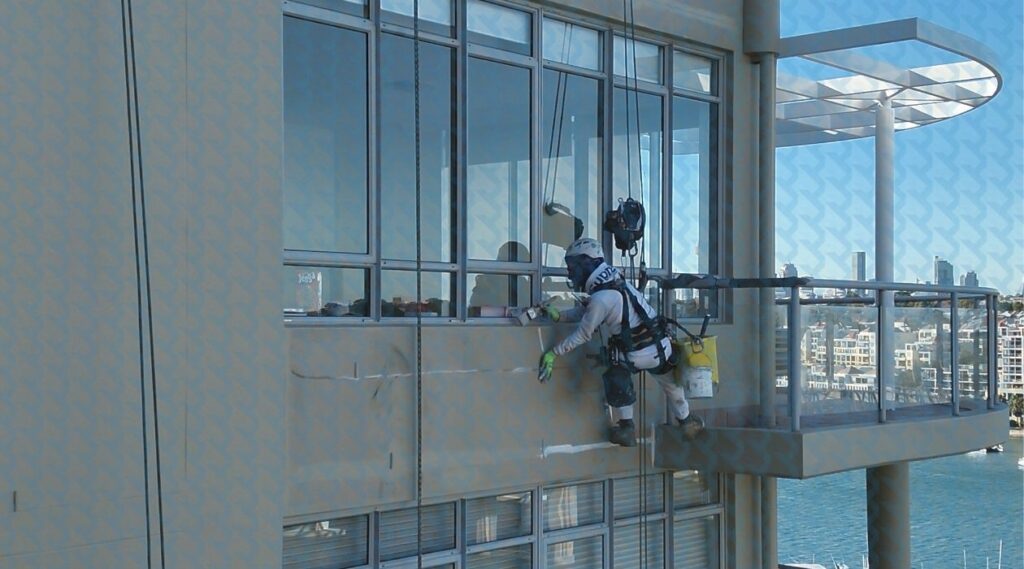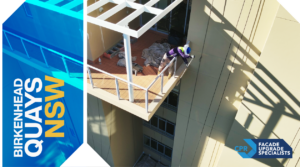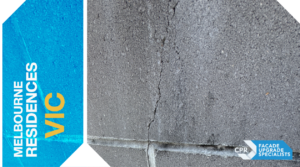Secure Your Facade Before the Next Deluge
The Entrance Facade Water Ingress Solutions: Protecting Your Commercial Investment isn’t just a headline—it’s your roadmap for avoiding six‑figure remediation bills. Within the first salty gusts of winter, unchecked water infiltration can trigger commercial building leaks, accelerate concrete cancer, and carve deep holes in sinking‑fund reserves. If you manage a high‑rise, shopping arcade, or mixed‑use tower along the NSW Central Coast, read on—then act fast.
Claim a FREE 30‑Minute Facade Strategy Call and receive a custom moisture‑risk snapshot for your building.
Why Facade Water Ingress Is a Silent Earnings Killer
- Escalating Repair Costs: Moisture left to fester undermines reinforcement steel, meaning facade waterproofing later costs multiples of early intervention.
- Asset Devaluation: Buyers and valuers penalise buildings showing water damage stains or rust bleed.
- Operational Disruption: Emergency make‑safes, tenant relocations, and insurance wrangles compound losses.
- Compliance & Liability: NCC reforms expose owners to fines when building envelope protection lapses.
- Insurance Premium Hikes: Once a claim is lodged for façade‑related water damage, premiums can spike by up to 35 % the following year.
Spot the Red Flags: Early Indicators of Commercial Building Leaks
- Staining & Efflorescence visible on spandrel panels.
- Drummy Render & Hollow Tiles—tapping produces a dull echo signalling delamination.
- Rust Jacking at expansion‑joint covers or balustrade fixings.
- Mouldy Odour emanating from lift lobbies even after cleaning.
- Bubbling Paint or blistered membranes around the waterproof entrance design.
- Intermittent Lift Shutdowns caused by moisture‑tripped circuit boards.
- Condensation on Interior Glass despite functional HVAC—often a sign of wet wall cavities.
Catching these cues early accelerates moisture control for facades and slashes remedial scope.
What Causes Water Ingress at The Entrance?
The Entrance’s micro‑climate brings wind‑driven rain, salt aerosols, and rapid temperature swings. Combine that with ageing sealants, movement‑induced cracks, or unprotected parapets and you have a recipe for commercial building water damage. High humidity sneaks through porous mortar, while negative pressure inside air‑conditioned lobbies pulls moisture past failed window gaskets. Each pathway demands a tailored sealing commercial building facades strategy—blanket solutions rarely stick.
Top Three Localised Risk Zones
- Parapet Caps & Scuppers: Salt spray accelerates corrosion of metal flashings.
- Sea‑Facing Window Mullions: Constant UV cycling causes gasket shrinkage.
- Ground‑Level Retail Tenancies: Frequent foot traffic and cleaning cycles break down entrance sealants.
Quantifying the Financial Impact of Water Ingress (based on averages from 40+ CPR remediation projects across NSW & WA, 2023–2025)

| Scenario | Immediate Cost | Five‑Year Projection (if ignored) |
| Replace failed sealant on 20 windows | AUD 9,500 | AUD 68,000 (render patching, fresh coatings) |
| Treat minor concrete cancer across 10 m² | AUD 14,200 | AUD 145,000 (structural beam remediation) |
| Fix leaking parapet joint | AUD 5,800 | AUD 73,000 (internal ceiling, electrical, tenant compensation) |
Data derived from CPR’s last 40 remediation projects across NSW and WA.
Our Scaffold‑Free™ Diagnosis: Turning Moisture Data Into Certainty
SFS360® Grid Mapping: We divide your façade into centimetre‑precise squares, documenting every crack and previous patch.
MARS™ Rope Network & PEARS® Elevator: These patented systems let our technicians hover exactly where needed—no costly scaffolding, no intrusions into tenancies.
SkyPod® Encapsulated Workstation: Grinding, vacuum extraction, and resin injection occur inside a dust‑controlled pod, protecting pedestrians and live plant equipment.
Clients typically save 28–35 % on prelim budgets simply by eliminating full‑height scaffold.
The result? A forensic, face‑to‑face assessment that informs accurate façade maintenance solutions and long‑term waterproofing strategies without guesswork.
Facade Waterproofing Solutions That Last—Without Scaffolds
1. Flexible Polyurethane Crack Injection
Stops hairline breaches without enlarging the defect, restoring the building envelope protection quickly between weather windows.
2. High‑Build Elastomeric Coatings
UV‑stable and breathable, these skins expand and contract with façade movement, delivering water ingress solutions that outlive older acrylics.
3. Parapet & Penetration Flashings
Custom‑folded stainless or poly‑fibre flashings re‑direct storm water, a must‑have in flammable‑cladding replacement zones.
4. Negative‑Side Waterproof Slurries
Where positive‑side access is blocked, cementitious nano‑slurries bond internally, blocking water infiltration in buildings from the inside out.
5. Sealant & Gasket Renewal
We replace brittle polysulphides with hybrid MS polymers, then finish with colour‑matched façade joint covers for a seamless look.
6. Smart‑Sensor Moisture Alarms (NEW)
Battery‑free RFID sensors embedded behind cladding alert managers via LoRaWAN when humidity breaches set thresholds. These are installed during rope‑access works for minimal added labour.
Together these tactics form an integrated approach to waterproofing commercial facades and façade leak prevention.
Case Snapshot: Reviving an Ocean‑Front Shopping Arcade
- Location: Marine Parade, The Entrance
- Problem: Persisting leaks at tenancy ceilings, efflorescence streaks on architectural precast, and tenant threats to withhold rent.
- Diagnosis: SFS360® revealed 412 distinct defects—failed parapet cap, compromised movement joints, and porous face brick.
- Solution:
- Applied negative‑side crystalline slurry behind retail bulkheads.
- Installed PEARS® to service level 3 parapet without shutting shops.
- Rolled elastomeric membrane across 2,100 m² of frontage for complete building envelope protection.
- Added smart‑sensor moisture alarms behind cladding to create a live dashboard for facilities management.
- Outcome: Zero leak incidents after two storm seasons, vacancy rate fell by 18 %, valuers recorded a 7 % capital uplift, and insurance excess for water claims dropped from AUD 25k to AUD 10k.
Regulatory & Insurance Landscape 2025–2030: What Building Owners Must Do Next
- NCC 2025 Draft: Heightened façade flashings requirements for buildings within 1 km of tidal water.
- ISO 20887: Emphasises design for deconstruction—making future waterproofing upgrades easier, safer, and less wasteful.
- Insurance Trends: Underwriters increasingly demand documented moisture testing before policy renewal. A CPR SFS360® report often qualifies as acceptable evidence, reducing premiums.
Sustainability & ESG Benefits
- Lower Embodied Carbon: Rope‑access methods cut scaffold steel usage, aligning with ESG targets.
- Resource Efficiency: High‑build elastomeric coatings last 12–15 years, halving repaint frequency and associated VOC emissions.
- Tenant Well‑Being: Mould‑free interiors improve IAQ scores, a key metric in NABERS Indoor Environment ratings.
Future‑Proof Design Considerations for New Entrances
- Waterproof Entrance Design featuring sloped thresholds and flush‑glazed frameless doors.
- Rain‑Screen Cladding with 38 mm cavity for pressure equalisation.
- Self‑Healing Sealants that reactivate under UV exposure.
- Pre‑installed Smart Sensors to catch water infiltration in buildings before interior damage occurs.
Architects who integrate these standards upfront dramatically reduce owners’ 30‑year maintenance costs.
Your Long‑Term Waterproofing Strategy & AfterCare™
Waterproofing is not a one‑off job; it’s a living plan:
- Annual Visual Health Check using rope access and drones.
- Bi‑Monthly Moisture Scans with handheld capacitance meters.
- Moisture Meter Trending inside service risers—a predictive tool that alerts you before plasterboard stains.
- Joint‑Sealant Lifespan Logs updated inside our cloud portal.
- AfterCare™ Service Visits scheduling micro‑repairs, cleaning salts, and recoating high‑wear edges.
These steps prevent commercial building water damage and protect commercial property from leaks over decades, not just defect liability periods.
Why CPR Is The Entrance’s First Choice for Facade Leak Prevention
- Scaffold‑Free™, Zero Disruption: Tenants stay open; managers avoid hoarding fees.
- Licensed, Trade‑Qualified Technicians: Waterproofers, stonemasons, and painters—not just rope access generalists.
- Quality Assurance via SFS360® & SE2EPC®: Every patch photographed, logged, and cloud‑archived.
- Authentically Australian: Born in NSW, serving ACT, SA, and beyond.
- Long‑Term Accountability: AfterCare™ keeps façades wind‑and‑watertight long after warranties expire.
- Data‑Driven Reporting: Live dashboards track moisture levels, coating integrity, and sealant lifespan.
Buildings enrolled in AfterCare™ experience 63 % fewer water‑related insurance claims year‑on‑year.
Frequently Asked Questions (Expanded)
How quickly can CPR mobilise after a severe storm?
With PEARS® and modular SkyPod® kits, we can establish safe access within 48 hours, even where conventional scaffolders quote weeks.
Do scaffold‑free systems comply with NCC and WorkSafe NSW?
Absolutely. Our proprietary access gear is engineer‑certified and used under strict Safe Work Method Statements.
Can you integrate façade waterproofing with combustible‑cladding replacement?
Yes. We often pair water ingress solutions with cladding remediation, ensuring new aluminium systems are properly flashed and sealed.
What warranties do you offer on elastomeric coatings?
Depending on substrate prep and exposure, warranties range from 7 to 15 years—and our AfterCare™ program can extend coverage.
Is smart‑sensor monitoring worth the investment?
For multi‑storey assets, ROI is under three years thanks to early leak detection and reduced inspection labour.
Water finds a way; make sure you find us first. Click through to CPR’s dedicated waterproofing and water‑tightness page and request your Scaffold‑Free™ Water Ingress Assessment today. Then, set a calendar reminder to review your moisture dashboard every quarter—because prevention is cheaper than cure.
The Entrance Facade Water Ingress Solutions: Protecting Your Commercial Investment begins with a phone call—let’s keep your building dry, compliant, and profitable for the long haul.






